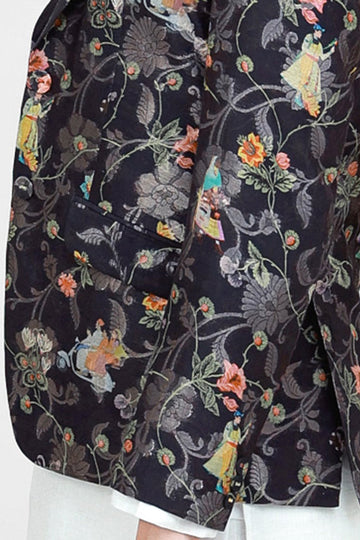Is sustainable clothing a hoax? Can clothes really be 100% sustainable? Are sustainable clothes even comfortable and visually appealing?
Let’s find out.
Sustainable fashion has been gaining popularity both in India and abroad as more and more consumers are getting aware of the global threat of increasing waste and changing climates. In fact, the green fashion market in India is predicted to grow at a CAGR of more than 10%.
This growth is proof that green fashion is surely going in the right direction. In this blog, let’s discuss sustainable clothing and why it truly is the need of the hour.
Understanding Sustainable Fashion

At its core, sustainable fashion is about mindfulness. It’s about:
- Choosing materials that honour our planet,
- Supporting local artisans who create with care
- Consuming with the awareness that every garment tells a story.
It’s about slowing down in an industry that thrives on speed.
Sustainable fashion brands focus on ethical sourcing, eco-friendly fabrics like organic cotton and hemp, and fair labour prices, where clothing is designed to last, be reused, or return to nature without harm.
It completely opposes the idea of mass-produced clothing that is incredibly affordable and typically ends up in wastelands in about a couple of years.
The State of Sustainable Fashion in India
Sustainable clothing is not a foreign concept in India. For centuries, Indians have been using sustainably woven fabrics like handlooms, textiles, and khadi along with natural dyes to create clothing that was both comfortable and beautiful.
Today, as global awareness of sustainability rises, many Indian designers and sustainable brands are going back to the roots, blending traditional ways with modern innovation.
From homegrown brands championing zero-waste production to artisans reviving age-old weaving techniques, sustainable fashion in India is a quiet revolution.
Government initiatives promoting organic cotton farming and bans on single-use plastics also signal a shift toward more responsible production.
But true change does not come from sustainable clothing brands in India alone—it begins with the choices we make as consumers.
Why Sustainable Fashion Matters Today

1. The Cost of Fashion on Nature
Did you know: The entire manufacturing process of a single cotton T-shirt takes over 2700 litres of water, from farming to manufacturing. Enough water for a person to drink for almost three years. Plus, the dyes used to give our clothes vibrant colours flood the river with harmful chemicals that end up harming aquatic life.
On the other hand, synthetic fabrics shed microplastics, which enter our oceans and even our bodies. These artificial fabrics are also non-biodegradable, flammable, and difficult to recycle.
Therefore, when we choose sustainable fashion, we choose to protect the very elements that sustain life.
2. Preserving India’s Craft Heritage
For centuries, Indian artisans have used pieces of organic fabric as a canvas to weave beautiful stories. These traditional techniques and skills were also passed down through generations until fast fashion threatened its legacy.
Manufacturing hundreds and thousands of clothes in a day with heavy and advanced machinery made clothes affordable and readily available, but the flip side of the coin was filled with pollution and a threat to nature.
By supporting sustainable brands that collaborate with artisans, we help preserve craftsmanship that is disappearing in the face of mass production. These clothes are made with much better quality and contribute to the nation's economy.
3. A Shift in Consumer Mindset
More Indians are embracing slow fashion, investing in quality over quantity. Conscious consumerism is rising, where people ask, Who made my clothes? What impact does my purchase have? The answers shape a future where fashion is not fleeting but meaningful.
How Consumers Can Support Sustainable Fashion

- Buy Less, Choose Better: As consumers it is our responsibility to invest in safe and well-made pieces rather than trend-driven fast fashion.
- Support Ethical Brands: Research out and buy from brands like Adam Leaves that prioritise sustainability and ethical practices over profits.
- Understand Certifications: To check if the brand is truly sustainable, look for labels like GOTS (Global Organic Textile Standard) and Fair Trade that ensure ethical production.
-
Spread Awareness: Talk about sustainable fashion, share information, and inspire others to make mindful choices.
Conclusion
So to answer your questions:
No, sustainable clothing is not a hoax. Yes, clothes can be 100% sustainable. And yes, sustainable clothes are just as comfortable and visually appealing as mass-produced clothes.
Nature never rushes, yet everything is accomplished. What if fashion followed the same principle? Sustainable fashion is not about sacrifice but about harmony—between style, people, and the planet. In a country where tradition meets innovation, India has the potential to lead the way in conscious fashion. The choice is in our hands, woven into every thread of what we wear.
If you are interested in buying sustainable clothing, you can check out Adam Leaves. Our clothes are made using natural and 100% eco-friendly ingredients like linen, organic cotton, hemp, and silk. We work closely with skilled artisans to create versatile garments that can make a difference.
Our collection includes blazers, jackets, shirts, vests, and kurtas. Shop Now!
FAQs About Sustainable Fashion
1) What is sustainable fashion?
Sustainable fashion refers to any clothing, accessories, and footwear made using methods and techniques that reduce environmental harm. It includes using eco-friendly materials, ethical labour practices, and minimising waste. The goal is to create fashion that is kind to both people and the planet.]
2) What makes a fashion brand sustainable?
A sustainable fashion brand prioritises:
- Ethical production
- Eco-friendly fabrics
- Fair wages
- Reduced waste.
It avoids harmful chemicals, supports slow fashion (quality over quantity), and promotes recycling or upcycling to minimise environmental impact.
3) How can fashion be sustainable?
Fashion can be sustainable by using organic or recycled materials, adopting ethical labour practices, reducing waste, and encouraging mindful consumption. Brands can focus on durability, repairability, and recycling to extend a product’s life cycle.
4) Why is sustainable fashion important?
Sustainable fashion helps protect the environment by reducing pollution, conserving resources, and promoting ethical labour practices. It fights against the negative effects of fast fashion, ensuring a better future for both people and the planet.





